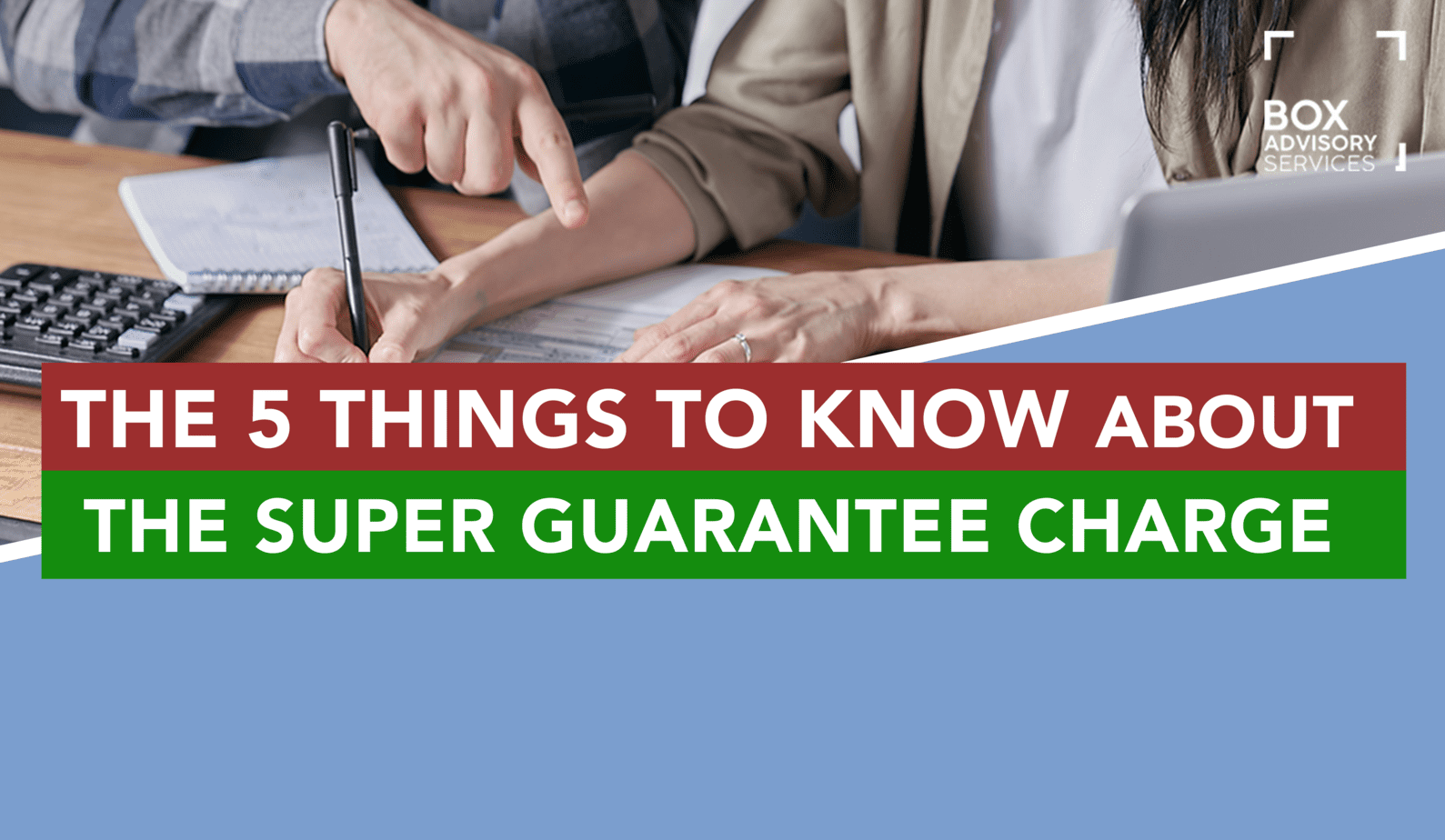
BY
|
Must-Know Details About the Superannuation Guarantee Contribution
As a business owner, you have a lot of responsibilities. Not only do you need to worry about tax obligations and payroll, but you also have to stay on top of financial reporting. Although it can be a lot to keep track of, it’s important to make sure that your business is compliant with all applicable laws and regulations.
This includes staying on top of your employee’s minimum superannuation guarantee contributions. Failure to do so could result in you having to pay a super guarantee charge – a penalty incurred for not paying an employee’s super guarantee on time.
So, if you have found yourself in this position, here are a few things you need to know about the super guarantee charge.
Paying Your Super Guarantee In Time
The best way to avoid paying the super guarantee charge (SGC) is to pay your employee’s super guarantee on time. In order to do this, you need to stay on top of your payment due dates. There are at least four key dates to keep in mind:
| Quarter | Period | Payment Due Date |
| 1 | 1 July – 30 September | 28 October |
| 2 | 1 October – 31 December | 28 January |
| 3 | 1 January – 31 March | 28 April |
| 4 | 1 April – 30 June | 28 July |
If You Miss the Deadline, You Need to Lodge a Super Guarantee Charge Statement
If you don’t meet the quarterly payment deadlines above and fail to contribute to your employee’s super fund on time, you will be required to lodge an SGC statement. The statement is essentially an ATO form that you’ll need to complete if you haven’t paid the super guarantee on time or in the correct fund.
The statement must be lodged, and the charge must be paid by the following due dates:
| Quarter | Period | Payment Due Date |
| 1 | 1 July – 30 September | 28 November |
| 2 | 1 October – 31 December | 28 February |
| 3 | 1 January – 31 March | 28 May |
| 4 | 1 April – 30 June | 28 August |
If you think you’re going to miss the due date as well, you can apply for a lodgement extension.
Late Payment Offset
The ATO does also give you the option to offset a late payment amount for one of your employees against your SGC liability if you’ve made a late payment to an employee’s fund before the SCG assessment is raised.
However, you’ll need to apply for an offset election within four years of the date of your original SGC assessment, and the ATO needs to approve the election.
Carry Forward Your Late Payment
The late payment can also be used as a super guarantee payment for the quarter when it is paid or for a future quarter.
You Need to Calculate the Superannuation Guarantee Charge
The penalty amount for late super guarantee payments includes:
- The super guarantee shortfall (i.e. the amount you haven’t contributed or contributed after the due date);
- Nominal interest of 10% per annum; and
- An administration fee.
To make things easier, the ATO provides employers with a super guarantee charge statement and calculator tool, which helps you determine if you’re required to pay the SGC for your employees and if so, how much that equates to.
Note: the charge is not tax-deductible.
How to Maximise Your Superannuation Guarantee Contributions
Maximising your superannuation contributions may sound daunting, but we promise it’s easier than you think. By being proactive and understanding the ins and outs of the superannuation provisions, you can significantly boost your retirement savings. Here are some actionable steps to take:
- Plan Ahead – Start early and consistently contribute towards your superannuation guarantee. The power of compound interest means your superannuation can grow exponentially over time. Remember, the sooner you start, the better.
- Salary Sacrifice – Consider a salary sacrifice strategy. This involves directing a portion of your pre-tax salary into your superannuation fund, potentially increasing its balance and lowering your taxable income.
- Government Co-contributions – If you’re a low—or middle-income earner, you may be eligible for Australian Government co-contributions. These are where the government tops up your super contributions, helping you save for retirement.
- Review and Consolidate – Having multiple superannuation accounts can cost you in fees and lost growth. By consolidating your superannuation into one account, you could maximise your return and save on fees.
- Monitor Investment Performance – Stay updated with your superannuation fund’s performance. Always compare it with other funds in the market and switch if necessary.
No matter your age or current superannuation balance, taking these steps can help you effectively maximise your superannuation guarantee contributions. There is always time; there’s never a bad time to start thinking about your retirement plans.
If You Miss the SGC Deadline, Additional Penalties May Apply
According to the ATO, failure to provide the SCG statement and payment on time could result in a further penalty of up to 200% of the initial charge. You could also face an administrative penalty if you pay less than the required SGC amount, which could be up to 75% of the shortfall.
Suppose you don’t comply entirely with the super guarantee charge requirement. In that case, the ATO may act as they deem appropriate.
For example, they’ll set a specific time period for paying the super guarantee charge. If you don’t adhere to the deadline direction, you could face criminal charges, which can mean further penalties and even jail time.
Also, the ATO may issue a “director penalty notice” that would make the company director personally liable for the super guarantee charge amount. From there, they may also pursue legal action in response to the notice.
Key Takeaways
The super guarantee is a legislated amount employers must pay their eligible employees. The charge applies if you don’t pay the minimum amount of super into your employee’s nominated fund by the quarterly due date.
- If you’re an employer and don’t pay the right amount of super – or any super – for your employees, you may have to pay the super guarantee charge.
- The best way to avoid paying the super guarantee charge is to stay on top of your deadlines. However, we understand that mistakes can happen. If you need help with your superannuation obligations, the Box Advisory Services team can assist with various payroll services.
- Many small business owners face the difficult task of balancing employer obligations with a reliable and consistent payroll function. However, by outsourcing your financials to someone who knows how to keep on top of these responsibilities, you can keep your business compliant. Plus, you can even save on the cost of hiring an HR or payroll staff member to manage your payroll needs.
If this sounds like something you may be interested in, get in touch today.
FAQs
What is the role of the Superannuation Guarantee in retirement planning?
The Superannuation Guarantee (SG) plays an instrumental role in retirement planning in Australia. Under the workflow of the Superannuation Guarantee, employers are legally obligated to contribute to their employees’ superannuation funds.
These contributions serve as a financial cushion for people once they retire. By mandating these contributions, the SG ensures that all employed Australians are gradually building a retirement fund. This setup provides a more substantial financial security net in one’s golden years, reducing reliance on the Age Pension.
Additionally, the SG creates an environment that encourages further personal contributions to super funds. Together with employer contributions, these additional personal contributions can significantly amplify the growth of the retirement fund, thereby enhancing retirement outcomes.
So, the Superannuation Guarantee operates as a framework for compulsory employer contributions, nurturing a culture of long-term saving and investment for retirement among working Australians.
How is the Superannuation Guarantee calculated?
For you to calculate the Superannuation Guarantee (SG), you need to understand that it’s based on your employee’s ordinary time earnings (OTE). You should consider their regular work hours, including any over-award payments, bonuses, commissions, and shift loading.
The formula is quite straightforward. First, you need to find out the employee’s OTE for the quarter (whether that is three months or a different length of time that you use for your payroll). After identifying the OTE, you multiply it by the current SG rate.
As of July 2021, the SG rate is 10%. To illustrate, if an employee has an OTE of $5,000 for the quarter, the super contribution would be $500 (10% of $5,000).
It’s important to note that the SG rate is set to gradually increase to 12% by July 2025. Keeping track of these legislative changes will help you calculate the Superannuation Guarantee contributions accurately.
To break down these calculations and ensure you’re compliant with the Superannuation Guarantee (Administration) Act 1992, you may find it helpful to use the ATO’s superannuation guarantee contribution calculator. It’s designed to help you determine the exact amount you need to contribute towards your employee’s super.
What are the benefits of the Superannuation Guarantee in Australia?
The Superannuation Guarantee (SG) provides many benefits to employees throughout Australia, contributing towards a comfortable retirement. The substantial advantages include the following:
- Compulsory savings: The SG legislation ensures a part of your income automatically goes into a superannuation fund. Even if saving is not your strength, this system guarantees that you’re setting some money aside for retirement.
- Employer contributions: Your employer must legally contribute to your superannuation fund. This is an extra 11% on top of your salary as of July 1st, 2021, which will increase to 12% by 2025, aiding in growing your retirement nest egg.
- Tax advantages: The complying super fund is taxed at a lower rate than other investment types, standing at 15% as opposed to the standard tax rates that can be as high as 47%.
- Inflation protection: Many superannuation funds invest in various sectors, including aggressive assets like shares, providing a certain amount of inflation protection. This ensures your savings keep up with the rising cost of living over the years.
- Insurance protection: Many superannuation funds provide insurance for their members. This includes life insurance, income protection Insurance, and total permanent disability (TPD) insurance. These insurance policies act as a safety net offering financial security.
Disclaimer:
Please note that every effort has been made to ensure that the information provided in this guide is accurate. You should note, however, that the information is intended as a guide only, providing an overview of general information available to contractors and small businesses. This guide is not intended to be an exhaustive source of information and should not be seen to constitute legal or tax advice. You should, where necessary, seek a second professional opinion for any legal or tax issues raised in your business affairs



